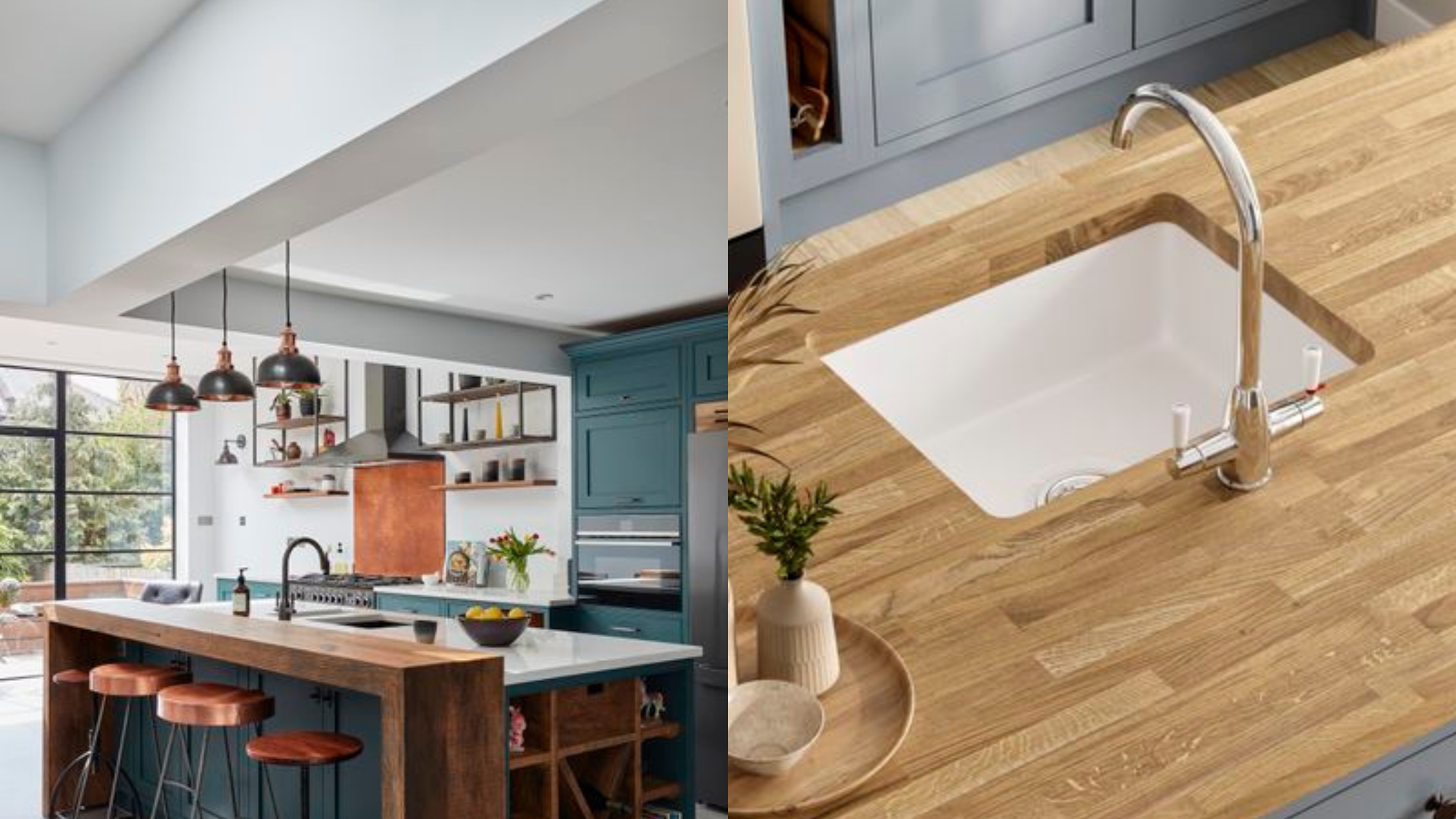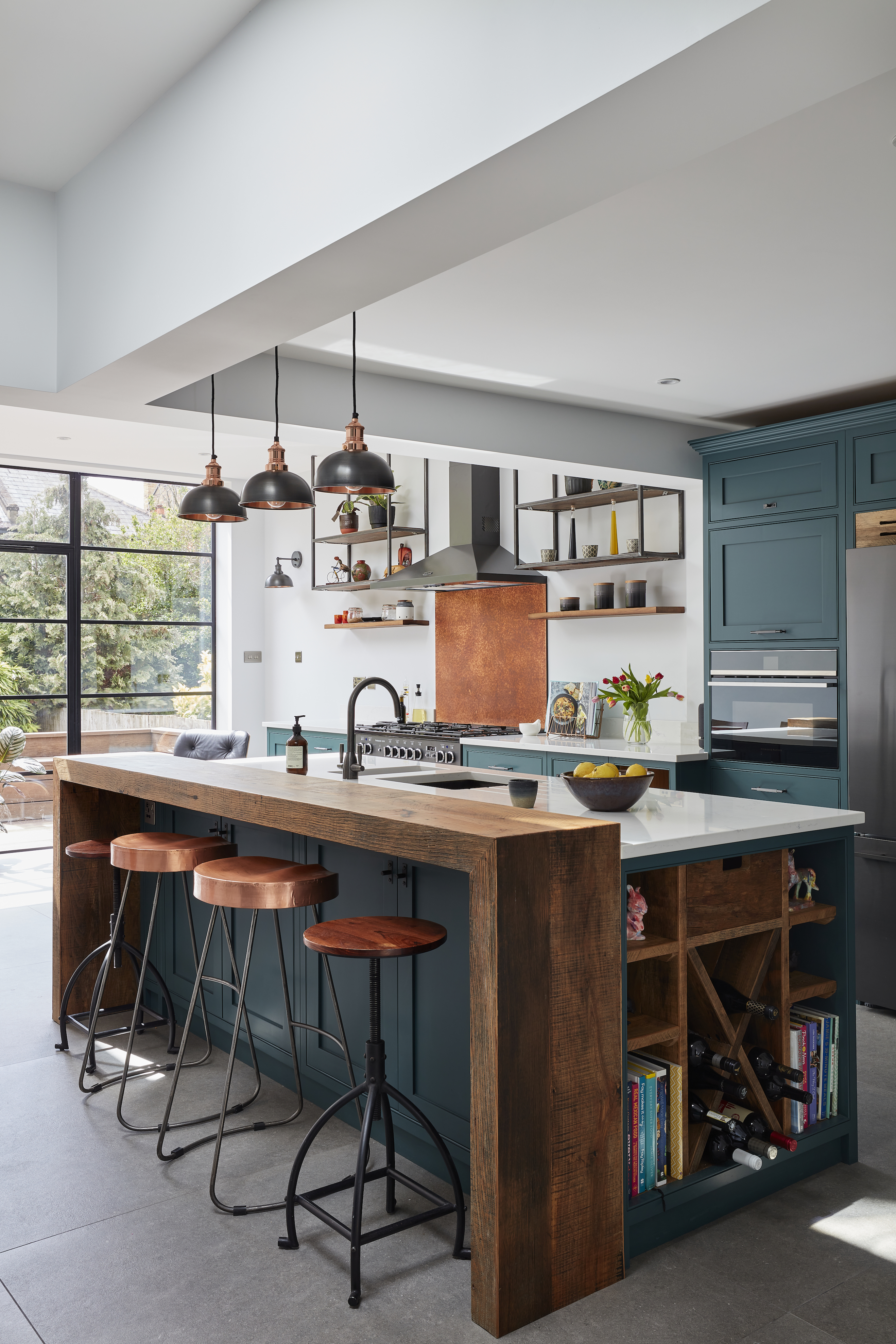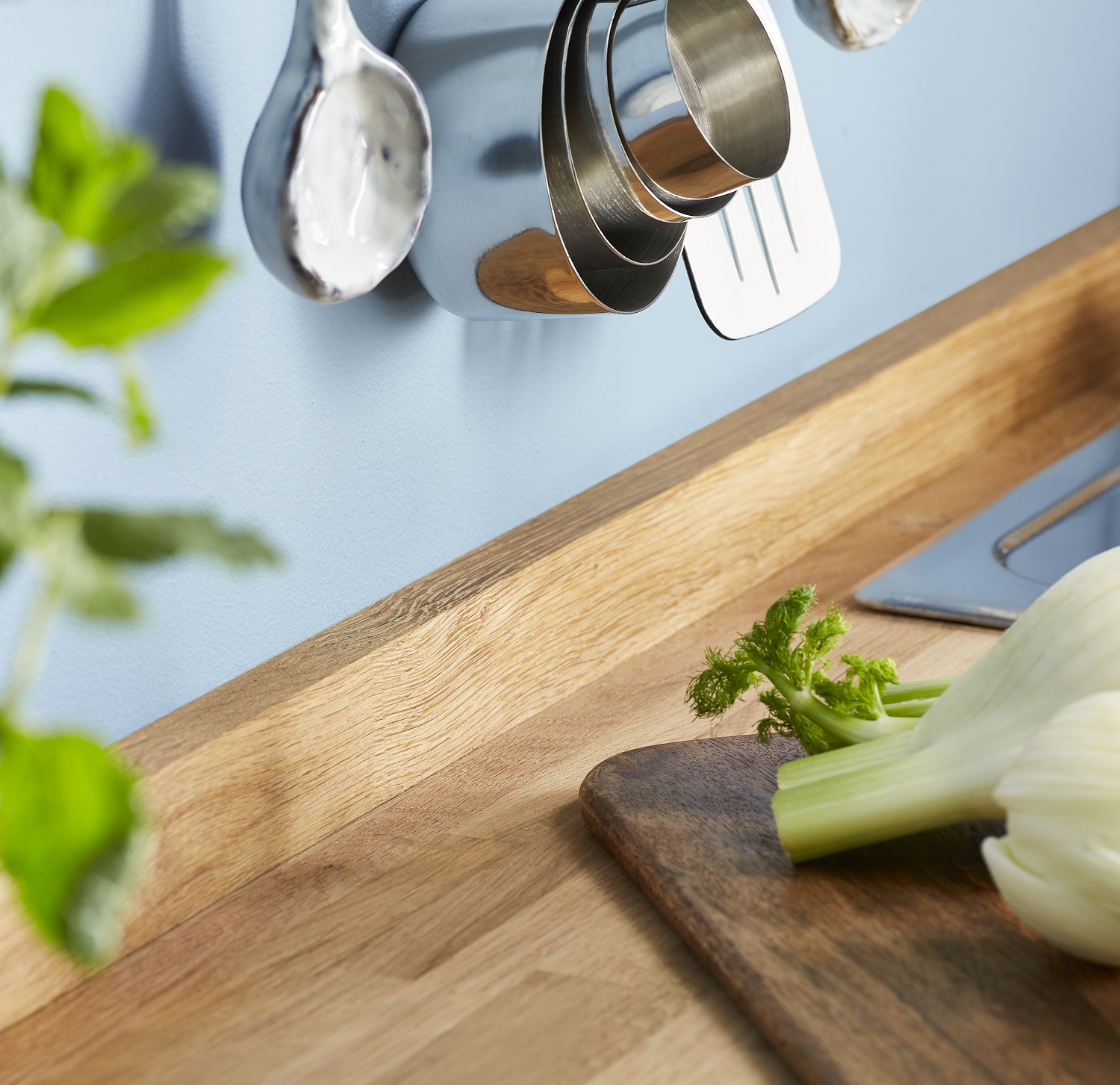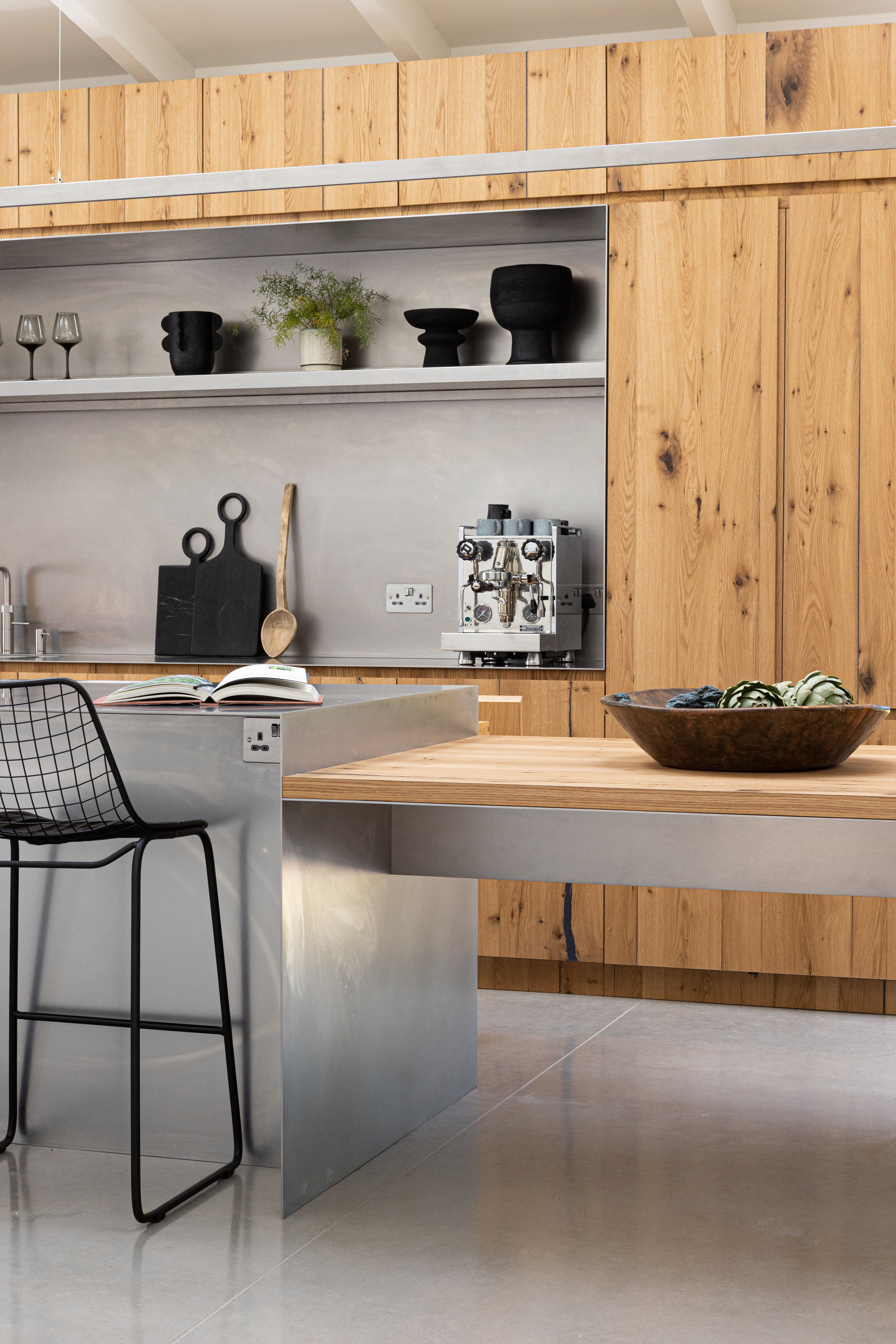

Knowing how to seal a butcher block countertop is crucial to keep the wood looking its best as well as staying hygienic.
Butcher block countertops are a great option for a kitchen, introducing an appealing natural material, but they do need particular care if they’re to stay stain-free, shrug off water, and remain bacteria-free. While it’s important to know how to clean countertops to keep them in good shape, for a counter that lasts and stays looking beautiful for years to come sealing butcher block countertops is a must.
But what is the best finish for butcher block and how should you clean countertops? We reached out to DIY and kitchen experts for all the information you need to know.
How to seal a butcher block
There are a range of products on offer as butcher block sealer. "For sealing the wood you need oil, wax, or varnish," says Michael Rolland, DIY expert, and MD of The Paint Shed. The goal? "Sealing is not the same as painting and is more about protecting the wood than changing its appearance," he says.

Michael is the Managing Director of The Paint Shed. He is the fourth generation of the Rolland family to lead a business within the paint & coatings industry since the family's inception within industry dating back to 1875.
There are three types of sealants to use on butcher block countertops: wax, oil and film finish. And, there are two types of oil sealants: evaporating and polymerizing. The best option for your kitchen depends on what you intend to do on the surface.
How to use oil-based butcher block sealants

No matter which type of oil you choose to use, make sure it’s labeled safe for surfaces that come in contact with food. Also, some oils, like olive and vegetable oil, will go rancid. Avoid using them.
Evaporating oils — An evaporating oil evaporates so it requires more applications than a polymerizing oil. During the initial sealing process, you’ll need to apply many coats. Some woodworkers suggest a coat a day for a week, a coat a week for a month, then a coat a month for the first year. After that, twice a year, depending on the amount of use. Examples of evaporating oils include:
- Mineral oil
- Walnut oil
- Coconut oil
Restaurateur Paul Kushner, mixologist and CEO of My Bartender cautions that while mineral oil is easy to use "you will need to reapply it more often, probably once a week. You simply pour oil onto your clean butcher block and rub it into the wood surface until absorbed. It gives the wood a rich finish, and will keep your surface from cracking as the humidity changes," he says.

PaulKushner founded MyBartender, a beacon of cocktail creativity and expertise. He has looked after many bar countertops which have seen their share of wear and tear. He has lent his expertise to numerous bars and restaurants, aiding them in elevating their offerings and overall customer experience.
Polymerizing oils — A polymerizing oil bonds with the wood, clogging the pores, and sealing them. They don’t require as many applications as an evaporating oil, are easier to maintain, and are less likely to stain.
To effectively seal your butcher block with a polymerizing oil, follow this regimen:
- Apply a coat of oil with a soft cloth.
- Wait 15 minutes.
- Buff it in.
- Wait 24 hours and repeat two more times.
Examples of polymerizing oils include:
- Tung oil
- Food-grade linseed oil (Do not use boiled linseed oil. It is toxic.)
- Jojoba oil
- Grape seed oil
We particularly love these oils for sealing a butcher's block countertop:
- The Real Milk Paint Company’s Pure Tung Oil contains a Citrus Solvent rather than harmful VOCs (volatile organic compounds — which according to the EPA, expose people to very high pollutant levels).
- Walrus Oil’s Cabin Walls & Hardwood Floors combines commercial-grade tung oil with perilla seed oil to hasten drying. It’s 100 percent food grade and completely plant-based.
- Howard Cutting Board Oil is food-grade mineral oil enriched with Vitamin E
How to seal butcher block countertops with film finishes

Film finishes like polyurethane, or resin-modified oils contain harmful VOCs which, when emitted as gases, can have some adverse health effects. If you do opt for this type of protectant, always use a VOC-containing film finish in a well-ventilated area and wear personal protective equipment. If you want to use a film finish in your kitchen, most are considered non-toxic when fully cured. But, cutting on it and potentially ingesting bits of finish in your food, is concerning.
That said, there are some pros to choosing a film finish for your butcher block. Unlike filling the pores with oil which repels water, a film finish provides a protective, plastic-like coating which is better at preventing stains. With proper care, a film finish lasts longer and the product doesn’t have to be re-applied, like oils.
To apply a film finish, always start by sanding the surface. Begin with 120-grit sandpaper and work up to 400-grit. Always sand with the grain of the wood, not forgetting the edges. Once it’s as smooth as glass, apply the finish following the manufacturer’s directions.
- Waterlox Original Sealer Finish is a resin-modified tung oil/mineral spirits product that is food-safe and non-toxic when cured.
- Zinsser Bulls Eye Shellac is easy to clean and cures to create a non-toxic finish.
- Polyurethane gives your countertop a plastic-like coating that’s preferred for heavy water exposure, like around sinks.
How to seal butcher block countertops with wax finishes

Wax can give butcher block countertops a pleasing appearance, and might be preferable for some woods. "If you have hard, ingredient-rich, oily, and dark wood surfaces such as cedar or mahogany then a wax may be a better choice," says DIY expert Michael Rolland. Apply according to instructions.
Natural waxes, like this beeswax for countertops from Amazon, are food-safe, non-toxic, and don't contain any harmful VOCs. Plus, it's less greasy than mineral oil, making it easier to apply and longer-lasting.
Simply rub the wax into the countertop with a cleaning cloth, like one of these microfiber cloths from Amazon.
Other things to consider when sealing your butcher block
- Choose one type of finish or the other. Mixing a film finish with oil creates a mess. And, if you want to refinish an older butcher block with a different type of finish, you will need to completely remove the old one.
- Some products mix beeswax with oil. The wax helps the wood to repel water better than oil alone. These finishes are applied just like an oil finish.
- Food-safe status isn’t reached until the product is totally cured, which takes about 30 days, on average. Just because the surface is dry doesn’t mean it’s ready for contact with food.
- To prevent stains, always remove food waste promptly, wash the countertop with a hot soapy cloth, and towel dry.
FAQs
What is a butcher block counter?
Historically, a butcher’s block was a piece of wood created by laminating small blocks of wood together, with the end grain exposed on the surface. This method used leftover scraps of wood to create something more durable than a solid slab, which is prone to warping. The durability of the laminated construction made something that could withstand the constant use and moisture of a butcher’s shop.
Now, butcher block is making its way into our home kitchens. You can find it in small cutting boards, island tops, and full-length countertops. You can even place one on top of the best kitchen trolleys. And, since many cabinet manufacturers now sell butcher blocks by the feet in home improvement stores, it’s easy to come by and affordable.
Be mindful that the name can be a little misleading when it comes to kitchen counters. "Most butcher block countertops aren’t made like traditional butcher blocks and aren’t designed to be used as a cutting surface," says Melanie Musson, a home improvement expert with Expert Insurance Reviews. "So, if you don’t cut on the surface, you have a wide range of options to seal your countertop, depending on the appearance and feel you desire."
Do you have to seal butcher block?
Knowing how to seal butcher block countertops is crucial because of the nature of timber. Wood is a porous material subject to expansion and contraction when exposed to moisture and humidity. Sealing it protects it from that exposure as well as preventing staining and a buildup of bacteria. Countertop stained already? Don’t panic. Just as you can polish countertops made from materials like granite, quartz, and concrete to remove marks, wood can be rescued. "A wood countertop can be sanded back if stained," says Alex Main, director at The Main Company. After that, you can seal it as detailed below.
As for the best sealer for butcher block countertops, this depends on how you will use it. The first question to ask when choosing a sealant is ‘Will you cut food on it?’ As we’ve mentioned this is often inadvisable. Modern butcher block products are constructed with the long-grain exposed. Cutting against the grain causes fibers to rise up, giving your countertop a fuzzy feeling. Woodworkers discourage cutting on a butcher block countertop for this reason.
However, if you believe you may use the countertop as a cutting surface for food, you’ll need to use a food-grade sealant. If not, you have more options.
How do you finish an unfinished butcher block countertop?
To finish an unfinished butcher block countertop use sandpaper to lightly sand the surface, working with the grain. Take a look at the instructions of the product you are using to seal butcher block for directions on which grit to use. Make sure to remove all the dust from the countertop, then apply the product according to instructions.
Should I polyurethane my butcher block countertops?
Whether you should use polyurethane on butcher block countertops depends on how you will use them. "Even the most properly applied polyurethane coating can contaminate your food unless you use a cutting board on top of the butcher’s block," says restaurateur Paul Kushner.
Our advice is that it’s always preferable to use a cutting board on butcher block countertop, which means using polyurethane is an option and one that provides long-lasting protection.
Knowing how to seal butcher's block countertops can seem overwhelming, but once you take note of the expert-approved tips above, the process should feel far simpler. To keep your counters looking their best, Just make sure that you know how to clean butcher's block countertops without damaging them.
Join our newsletter
Get small space home decor ideas, celeb inspiration, DIY tips and more, straight to your inbox!
Carol J. Alexander writes website copy, blog posts, and feature articles on home remodeling and construction topics from her home in the Shenandoah Valley of Virginia. In addition to Real Homes, notable clients include, This Old House, Family Handyman, and Florida Roofing magazine.
- Beth MahoneyFreelance journalist
- Sarah WarwickFreelance Editor